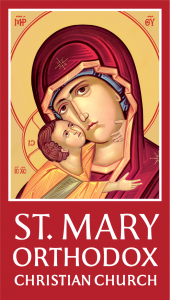“In Behalf of All and for All”: On the Offering of Holy Bread
One of the most overlooked contributions we can make to the Church is offering Holy Bread.
In fact, offering Holy Bread is one of the most important ways laypeople may participate in the Divine Liturgy. The process of offering Holy Bread underscores its importance. The offering begins by making the Holy Bread itself, a labor-intensive project.
Thankfully, for those in our parish who do not have the time or the ability to make Holy Bread, our Belles of St Mary allow individuals or families to purchase the bread for a reasonable price ($25). When the bread is made, it is stamped with a seal used specifically for this purpose. On the seal are the markings IC, XC, NI, and KA, one in each of the four squares in the center of the Holy Bread.
Based upon the Greek biblical language, IC stands for Jesus; XC for Christ; and NIKA for victorious. Before the Divine Liturgy, the Priest or Deacon chooses the loaf of bread with the highest quality and then cuts out the ICXC NIKA piece to be used as “the Lamb”, which is later consecrated as the Body of Christ for Communion. This piece is called “the Lamb” because Jesus Christ Himself was called “the Lamb of God.”
In addition to the centerpiece, the seal includes 10 other pieces, one for the Mother of God and nine others for various ranks of saints commemorated during the preparation service before Liturgy. All of these pieces are placed on the diskos next to the Body of Christ. The pieces represent the Church, Christ surrounded by His holy ones. The diskos is veiled and brought to the Holy Table by the Deacon during the Great Entrance.
When Holy Bread is offered, the person or family offering the bread submits the names of both the living and the departed. For this reason, families often choose to offer Holy Bread close to a birthday or anniversary of themselves or loved ones. During the preparation service, the Priest offers a prayer for each Orthodox person on that prayer list and places a piece of Holy Bread on the diskos for each as well, since they also are part of Christ’s Church. During the Great Entrance, the Priest prays publicly for each name submitted by those offering Holy Bread, regardless of whether or not they are Orthodox.
That is why each Sunday, the prayer list at the Great Entrance is different. In addition to the Holy Bread being used for the consecration of the Body of Christ, the remaining Holy Bread is used to distribute to the faithful, who have fasted in preparation for Communion. In Antiochian parishes, we also have a custom of sharing some of the Holy Bread with guests as a sign of our hospitality.
The offering of Holy Bread allows the person or family to participate intimately in the Divine Liturgy. They are literally offering, on behalf of the community, what becomes the Body of Christ. Furthermore, through the offering, they will receive special prayers for themselves and any of their living or departed family members and friends whom they wish to commemorate by name.
We encourage each individual or family in our parish to offer the Holy Bread at least once per calendar year. Individuals or families may join with other individuals or families to make the offering of Holy Bread together. For those who do not know how to make the bread, they may attend one of the Belles baking days for that purpose. In addition, they may simply purchase the Holy Bread from the Belles.
Want to Make Holy Bread (Prosphora) on Your Own?
Check out this video from the Antiochian Village:
A Holy Bread binder is available in our church hall on the south side of the gymnasium. Parishioners are encouraged to look through the book to find an open date to offer Holy Bread for themselves and/or their families.
One important final note: although many people combine offering Holy Bread with hosting the Coffee Hour, this practice is not required. Holy Bread may be offered even if a person is not able or does not wish to offer the Coffee Hour.




